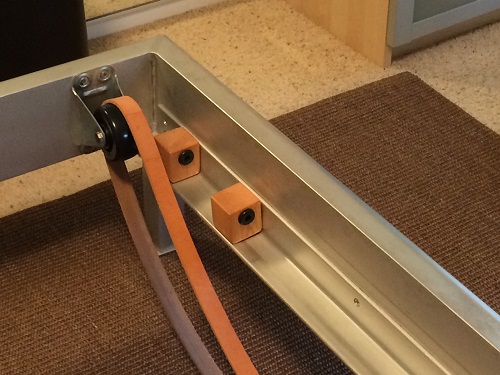Size does matter.
And I believe the 80” Gratz Universal Reformer is the ultimate partner for your Pilates workout.
It is efficient.
It can be unforgiving.
It is for exercise, and exercise is uncomfortable.
I am happy to participate in this conversation about some of the ‘Why?s’ of classical Pilates and classical apparatus. Let’s examine Joe Pilates’ original size of the Reformer, 80”, and see what this specificity can reveal to us about the Pilates Method.
It’s true. Brett and I enjoy a good nerd-tastic Pilates discourse.
However, we are very different Pilates practitioners.
Brett was a professional ballet dancer.
I was not.
Brett has a wonderfully flexible facility for movement.
My body type is toward the tighter end of the spectrum with regard to the back, hips, thighs and shoulders.
I have heard a number of flexible colleagues express the opinion that initially they didn’t like the confinements that learning Pilates placed on their mobility.
Confinements? What are they talking about?? This was not my experience.
But let’s get back to our 80″ Reformer. The apparatus gets its name from its intended purpose: to reform our movement.
reform: (verb) make changes in something in order to improve it.
The process of reforming something comes with rules or guidelines to follow.
The little wooden block in front delineates the 80″ necessary for reformation.
Joe Pilates has allotted you 80″ in which to perform his exercises.
All this is for a reason. Consider Joe’s choice as information rather than restriction.
The Reformation Golden Rule:
Closing the spring is the important part of the exercise.
Let’s review our guidelines. On our Gratz Reformer, the springs close completely just prior to the return of the carriage. This action is unique to the classical apparatus.
Now you must strive to return the carriage completely (that last inch) without the help of the springs.
It’s all you, baby.
Closing the spring completely and with control is in fact the single most over-arching goal of the entire Pilates system. On the classical apparatus it is the action of closing the spring that creates the lift and length in our bodies.
Long Stretch
This difference is most apparent in exercises like the Long Stretch and the Elephant. The Elephant is one of the first Reformer exercises one learns yet it is not easy to do well and close the carriage completely.
But let’s look closer at the Long Stretch. Modern Pilates apparatus may tempt you to push the carriage out as far as you possibly can.
However, If you move the carriage out too far on the classical apparatus you are stopped by the little wooden block.
The Reformer is sending you a message:
“You are in violation of the Reformation Golden Rule.”
The Reformer says no. This is not the objective of the exercise.
Consider that the lift and length required to close the carriage completely and with control (and maybe even stay there for a moment) may be essential to reform the body. Versus the enjoyable feeling of stretching out “all the way.”
Not to say you shouldn’t do things that are enjoyable, but it is often the exercises we don’t enjoy that are the most beneficial to us.
Jus’ sayin’.
Up Stretch
We have our Reformation Golden Rule (RGR) to help us with this lower body exercise. Again if you move the carriage out and hit the stopper, what has happened?
The Long Stretch Series is fraught with the peril of overworking the upper body and pushing out the carriage with the arms. This series is about opening and closing the carriage using the lower body, with the arms and upper body for balance only.
Not an easy feat, I agree. That’s why you need the Reformer to give you feedback.
The little wooden block is happy to help.
Semi Circle
The Semi Circle is about articulation. Without a confined space in which to work, the body gets too straight and stretched out, losing the need to articulate the back. So while it feels pretty good even when the carriage is out all the way, the benefit/challenge of articulation is lost.
Moreover, if the carriage goes out all the way to be against the little block for this exercise, you are missing out on the control and muscular action necessary to keep the carriage still as you articulate the spine.
In this case the little wooden block is letting you know that you are a cheater. 🙂
Create more space on the inside.
These 3 exercises are just a few examples of the benefits you receive by containing your exercises with the 80″ allotted to you by Joe Pilates.
Keep exploring the Golden Reformation Rule and close the carriage completely. Notice the lift and “inner stretch” of working in this manner.
That is the difference: stretching more inward for elongation of the body vs. stretching all the way out extending the body to take up more space. Work to create that space for yourself on the inside with more lift and length.
Thank you little wooden block!
A graduate of Vintage Pilates inaugural class of The Work, Andrea was thrilled to be invited into Teaching the Work under Jay Grimes, 1st Generation Master Teacher and former student of Joseph Pilates. She has comprehensive training through Excel Movement Studios in Washington, DC and Romana’s Pilates in New York.
Andrea is the owner of a private Pilates studio in Solana Beach, CA and is also an instructor at Vintage Pilates, Jay’s studio in Los Angeles.
She is priviledged to be a teacher and blogger forpilatesology.com which is dedicated to recording, preserving and spreading Joseph Pilates’ original work worldwide.
Find more information, contact Andrea and read theblog at www.pilatesandrea.com.


